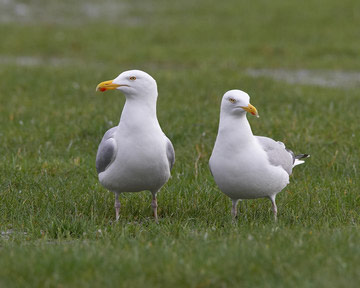
Herring Gull © Richard Steel
This well known ‘seagull’, whose calls are recognised by many from its weekly broadcast by BBC Radio 4’s Desert Island Discs, is becoming increasingly familiar to some residents of north Wirral as the habit of rooftop nesting takes hold. All of the eight tetrads with dots on the map were connected to rooftops in that area, in West Kirby, Hoylake, Birkenhead, Wallasey and New Brighton: one confirmed breeding through a pair with recently-fledged young, six probable breeding (two with birds seen building a nest, one pair in courtship display and three records of pairs observed in suitable nesting habitat) and one possible breeding with a bird in suitable habitat.
The few previous records of Herring Gulls nesting in the county were all on Wirral. In 1945 a nest presumed to be Herring Gull was seen on Middle Eye, Hilbre. A pair bred, rearing one chick, on a Hoylake rooftop in 1971 but were deterred by the householder in 1972, and in the 1976 national census of large gulls nesting on buildings there were records of a pair at West Kirby and ‘nesting’ at Heswall. At Inner Marsh Farm a pair built a nest in 1995 but did not lay eggs, and in 2003 a pair was seen on a nest but it is not known if they bred. The Cheshire and Wirral Bird Report for 2000 records a pair at Hoylake fledging one young, presumably from a rooftop although the site is not mentioned.
Rooftop nesting by Herring Gulls first started in 1910 in southwest England and is now widespread in Britain, accounting for about 11% of the species. Considerable effort and money has been expended in attempts to deter gulls in some places, almost always unsuccessfully (Rock 2005), and the numbers of nests increased by 10% a year in the quarter-century from 1976 to 2001: from 2,944 nests at 63 colonies in 1976, to 10,865 nests at 128 colonies in 1993-95 and 19,953 nests at 218 colonies in 1999-2002 (Mitchell et al 2004). Many householders do not like having gulls breeding on their houses but one of the main reasons that the species is flourishing is the messy habits of mankind. Herring Gulls feed mainly on inshore fish and discards from commercial or recreational fishing, waste sent to landfill sites and edible litter on urban streets.
In memory of Doreen Botwood

